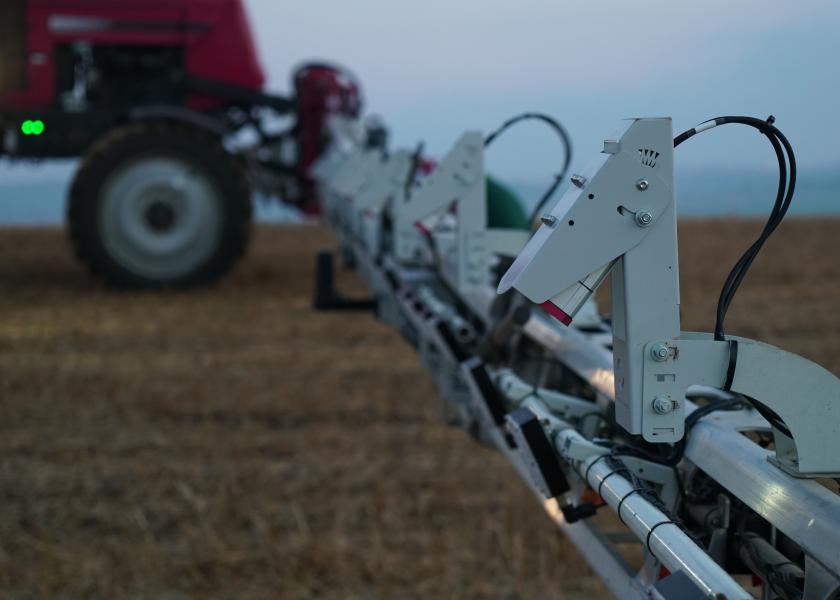Startup Greeneye Eyes Precision Spraying

An Israeli startup plans to have a handful of precision spraying units out in the field this spring applying herbicides only where its artificial intelligence system has identified weeds by growth stage and species.
Greeneye Technology has been in the field with its machines in Israel for the past three years–merging and building technologies around machine learning, artificial intelligence and automation.
“When farmers apply herbicides it’s to minimize damage to their crops. In many cases the weed pressure can be as low as 15%, and yet the traditional approach is to spray 100% of every field, every season,” says CEO Nadav Bocher. “Greeneye brings a transition from this wasteful practice to precise application. We are addressing a problem exactly where it is and in appropriate doses.”
He adds that in 2020 field trials, the technology reduced herbicide use by 78% on average, with some farmers seeing a reduction of 90% or greater.
Crops v. Weeds
Selective spraying technologies are solving two problems—pre-emerge applications that spray precisely any plant in the field detected as a weed and post-emerge applications that differentiate crop from weed and only spray the weeds in the field.
“Pre-emerge is an easier challenge from a computer vision standpoint,” says Bocher. “However, accurately spraying weeds amongst crops – green-on-green – is more complex. To achieve this, our proprietary system is trained to identify more than 250 different species of weeds in different field conditions and different crops. Triggering the nozzle is just the first step. We can also take it a step further and tell you what type of weed it is—down to the species-level.”
Currently, Greeneye is focusing on corn and soybeans, with development in cotton next.
“We are the first company to offer U.S. farmers a precision spraying system that is suitable for both green-on-green and green-on-brown applications. The only thing standing between massive adoptive of precision spraying is convincing them the tech is mature,” he says.
Investors in the company to date include Syngenta Ventures.
The Parts of the System
The selective spraying (SSP) system is ISOBUS compatible and installed on a new boom supplied to farmers as part of the package. Cameras are mounted along the boom with lighting to ensure visual accuracy in all field conditions and during nighttime operation. Computer processing units are also spread across the entire boom to have real-time analysis.
Bocher says the system is designed to integrate with any brand or size of commercial sprayer and precision spraying can be done at the same travel speed as broadcast spraying – 13 mph – while maintaining a 97.5% accuracy rate in weed detection and identification.
For the 2022 season, the company will have four of the systems (installed on four brands of sprayers) in operation in the U.S. Midwest.
“We have dozens of signed contracts with farmers already committed to the pay for the system for 2022 season,” Bocher says.
The current business model is for farmers to rent the machine as a service, but beyond this coming year, the company aims to sell a retrofit kit to farmers for their existing sprayer. According to the company, it takes about a day for its field service engineers to install the system on a machine.
Additional Advantages
“The benefits of our system go beyond herbicide reduction,” claims Bocher. “We can provide farmers with a detailed map of their field detailing the species of weeds that are present, enabling them to make more informed decision about the type of crop protection chemicals to use.”
In the Greeneye perspective, this level of precision is paramount to elevate the opportunities of chemical application, especially to control resistant weeds.
“It’s equally as strategic to increase the efficacy of the spraying pass as it is to reduce herbicide volume. When farmers are applying with Greeneye, they can afford to invest in more efficacious formulations and do complex tank mixes. And with resistance, that’s more valuable than ever.”
And the technology supports stewardship of the crop chemicals currently available.
“Drift is a huge issue. And with this regulatory environment, the practice of spraying the entire field won’t remain a popular option,” he says.
He adds that the third benefit of the system can help support farmers throughout the season. It’s for the on-board cameras and computers to provide in-field insights into issues such as disease developments and crop stress.
“In addition to the spraying capabilities which control the nozzles by the milliseconds, we are able to collect ultra-high resolution data from the entire field. This can be used to provide valuable insights to farmers and enable them to treat their field at the plant level,” Bocher explains.
The early feedback from its prototype systems placed with farmers has been valuable.
“Earlier this year, we launched our second-generation system, which includes a dual-spraying function that enables farmers to apply residual herbicides on a broadcast basis while applying non-residual herbicides precisely on weeds. We can master the algorithms for precision spraying, but we won’t see mainstream adoption without accommodating the fact that farmers also need to spray residual on an ongoing basis. It kept coming up again and again,” explains Bocher.







